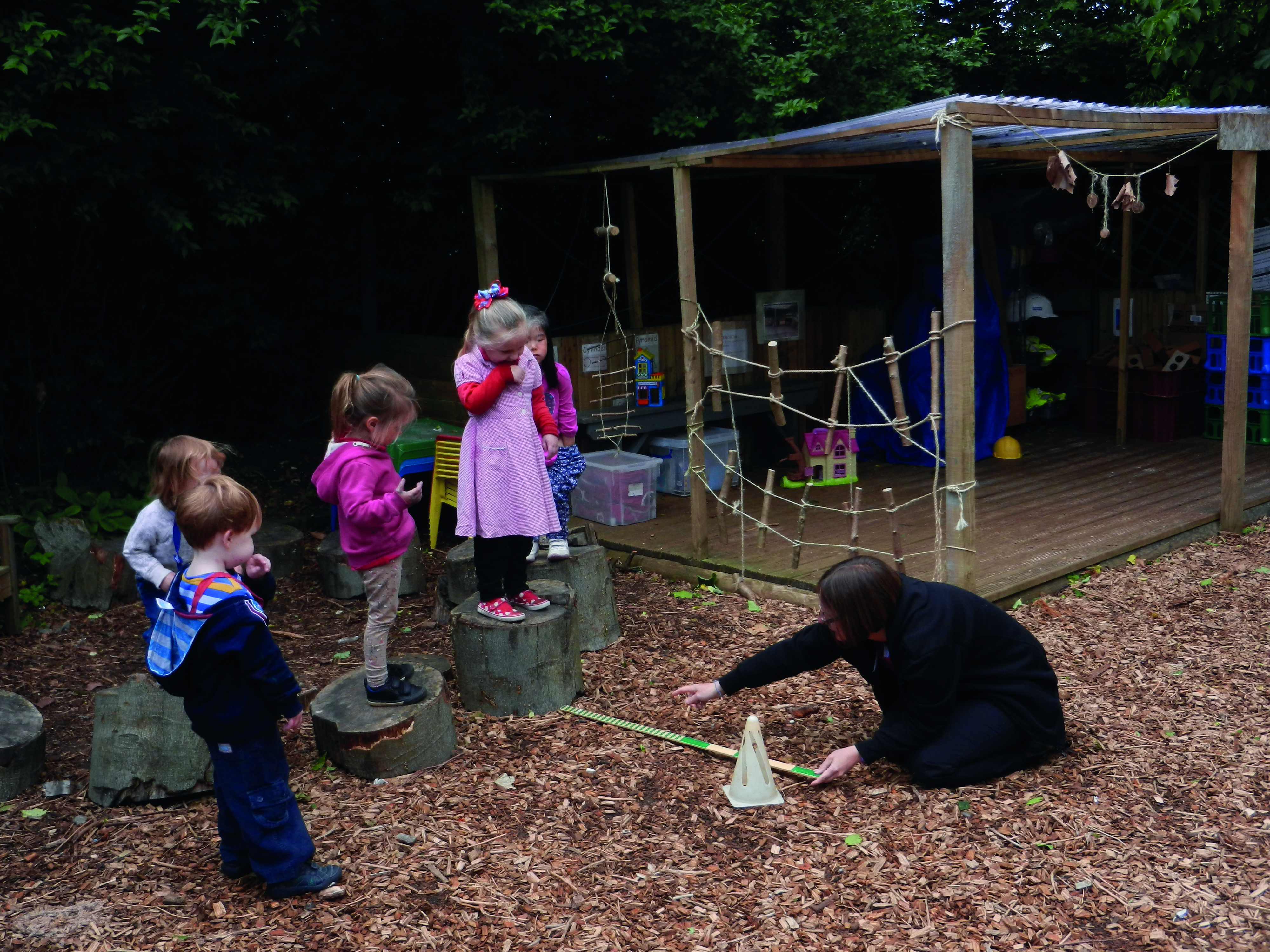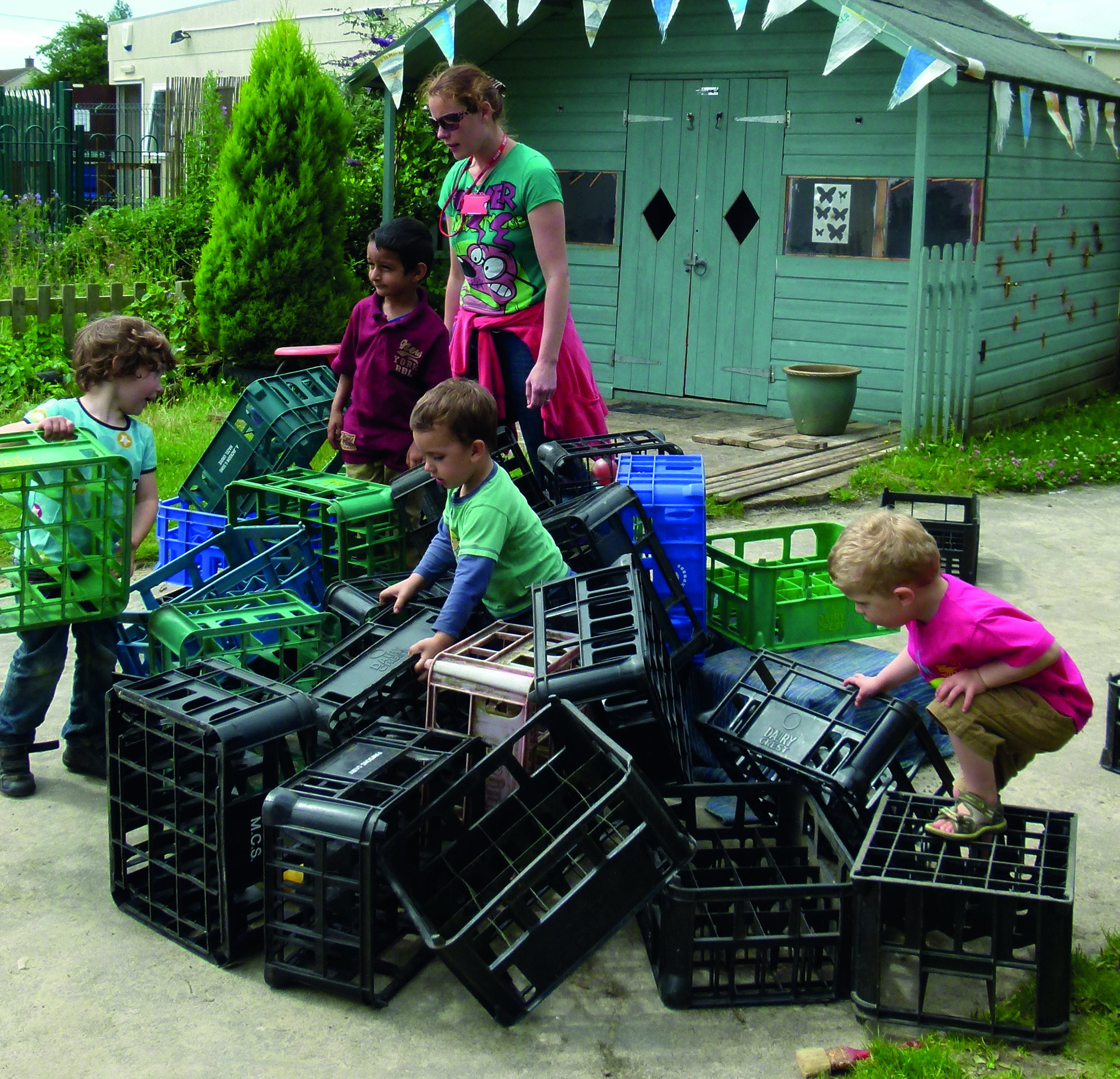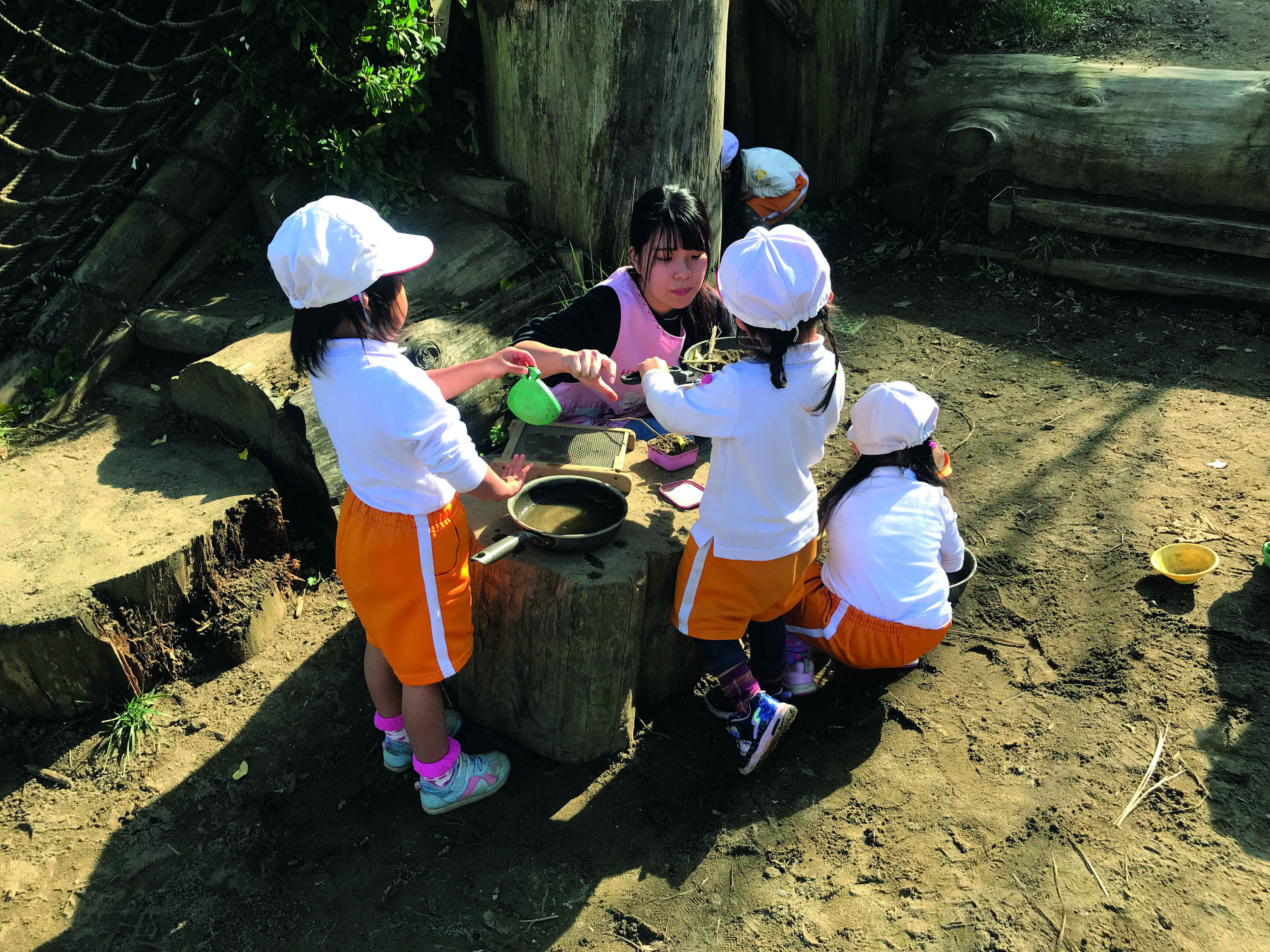
The lure of outdoor play – whether at your setting, out and about in the neighbourhood or on a trip further afield – is perfect for encouraging a rich flow of conversation with, and between, children.
Whatever the weather, children love to be outdoors, where fast, vigorous, challenging movements are a high priority. As practitioners, we can really exploit their delight in the potential of their own bodies – as a wonderful source of expressive development as well as being related to maths and technical language.
Communication obviously takes many forms, not just speech. Outdoors is also a place for signs and signals, mark-making opportunities, music and sounds.
Each UK nation’s early years guidance is unique, but they all place paramount importance on communication and language. The richness and diversity of your outdoor space will be even more crucial to children with little or no access to outdoor play or physical activity at home, so picking out potential improvements to the way you resource and manage outdoors will help address those deficiencies.
WHAT CHILDREN ARE SAYING
A new focus on communication and language outdoors will benefit from an audit of existing resources and opportunities. Take some time to observe and make notes as you identify what children are saying (to themselves, or to others) as they play in particular areas.
- Do you notice variations in the vocabulary, or the tone or volume of words used in significant locations?
- Do some places or features stimulate collaborative play and talk? Are others less well used? Why might that be?
- Do children use language differently between self-chosen and adult-led play?
- What non-verbal communicative gestures can you see?
- Are children using a wide range of natural and manufactured objects to mark-make?
- Do you hear children making to-and-fro conversation, or are their interactions largely questions and answers? Do you find yourself doing this?

Take photographs, video and audio clips, and then create a large-scale (A2 or bigger) communication and language ‘map’ of the play space – noting communication hotspots and cool spots, highlighting the type of language used (for example, imaginative, sporty, STEM), the types of play you have observed and how many children are together – either playing with, or alongside, one another.
If you can, share the map with the children, explaining why you have made it, and what each of the symbols you have used represents. Signs and symbols play a vital communication role in our world, so beginning to understand how and why they are used ‘in real life’ helps children with fundamental skills, from pattern-making and sorting through to mapping and constructing.
Use the map as an opportunity to explore the garden again, locating each place using the map and the features you have marked on it, such as play equipment, trees, sheds and pathways. Again, listen to the purposeful language children are using as they move around with you – can you identify and encourage positional language (‘on’, ‘over’, ‘up’, ‘through’…) or descriptive words (‘beautiful’, ‘wobbly’, ‘shiny’, ‘smelly’…)?
Use this information to highlight gaps in opportunity – for example, do children need more places to collaborate in big construction play? Perhaps they would benefit from hidey holes and retreats, or high prospect points? Could existing resources and equipment be used in new combinations or in alternative locations?

PLAYFUL PROMPTS AND RESOURCES
Curate story sacks specifically for outdoors, to include the laminated pages of favourite books and appropriate props. Explore the garden, seeking locations that would work as ‘scenery’ for the story so that telling it becomes a promenade around the garden, with children speaking and listening as they recall the plot, characters, setting and actions through big movements and big voices.
Narrate children’s activities and movements, including new and familiar words and phrases, including technical language. Mix your metaphors as much as you like and use a stick as a microphone, demonstrating that the way we narrate others’ activities is different from how we would describe them on paper, or how we would retell them as a story – ‘Samir leeeeeaps from the wall! Twisting and spinning in a stunning triple salchow yet landing as lightly as a mountain goat. Ten out of ten for Samir!’ Now ask children to narrate each other’s play as dramatically as they can.
Deepen children’s grasp of mathematical language through Parkour – urban gymnastics – in your garden. Watch the experts show off their skills online, asking children to describe what they see the athletes doing. Now go outdoors and find features you can use for Parkour – benches, walls, logs, play structures, tunnels, tyres and so on. Incorporate athletic words as well as maths words – ‘how many times’… ‘how high’… ‘you have five seconds’… ‘go back and repeat’… ‘do ten’… ‘stop start’…
In the mud kitchen, add science lab resources – pipettes, weighing scales, tall vessels, signage and scientific notation. Chemical equations may seem incomprehensible but displaying them, along with hazard signs and measuring equipment, will help show letters and numbers in different contexts.
Construction resources inspire imaginative and technical language – a collection of crates, blocks, tyres, planks, pallets, buckets, real bricks, ropes and tools is essential. Set up construction resources so that children have to work together to transport and build; talk and gestures will be vital in their collaborations. Create a narrative for children around construction, recognising that it is a very extensive industry: source A3 clipboards, squared paper and metre sticks to role-play architects; dress up the wheeled vehicles with cardboard to become diggers; rig up pulleys and ladders; make a builders’ merchant nearby and perhaps even a sales office, with publicity material (estate agents can be very generous with particulars of sold properties). Fill the construction space with ‘real world’ construction area signage – and grab opportunities to watch construction taking place nearby.
Den-building is a perennial favourite and can happen anywhere outdoors. Use your fixtures and features as a starting structure, adding tarpaulins, sheets, cut branches, and providing plenty of pegs, rope and clips. I like to build conversations around our den-building, linking materials and structures to stories we have shared, or events in children’s lives such as decorating a bedroom for a new baby, or going camping.
Outdoors is without doubt the best place to encourage and support superhero play. The space, the features, the level changes, the challenges all combine to create a canvas for expressive and imaginative ideas to flow. Silver-coloured exposure blankets make excellent superhero cloaks – add face masks, bandanas and props and take over the whole of the outdoors. Join in yourself (I like to be the baddie) to model fearless superhero movements and words, both of which should be dramatic, overblown and involve displays of emotion and bravado.
Boing Whoosh RolyPoly!
Early years movement specialist Jasmine Pasch has developed a handy way of remembering the types of movement we should be encouraging children to engage in every day as part of their 180 minutes of physical activity: Boing Whoosh RolyPoly!.
- BOING: ‘Up and down movements in a vertical axis,’ says Ms Pasch. Babies and toddlers bouncing on an adult knee, being tossed into the air and caught, bouncing on the bed and simply being lifted up and down are all early forms of ‘boing’. Independently mobile children will find this bounciness in hanging upside down, climbing and jumping from height, hopping and skipping, trampolining and springing up.
- WHOOSH: ‘To and fro movements such as being rocked from side to side’ introduce very young children to ‘whooshing’, explains Ms Pasch. Older ones will enjoy rocking and spring toys, swings and zip wires, wheely toys and slides, and simply running with the wind in their hair.
- ROLYPOLY!: ‘Movement where the body rotates’ is her description of RolyPoly!. Spinning and twirling are among young children’s favourite movements and are crucial for their balance, co-ordination, and core strength. Somersaults and rolling down a mound are complex body movements that require control and courage and are milestones in children’s physical development.
Ensuring children engage in these movements several times each day will contribute to their overall balance, agility and co-ordination.
Jasmine Pasch is an Early Education associate and advocate for playful, energetic movement, www.jasminepasch.co.uk
Physicality grab and go kits
A grab and go kit is an convenient way to provide a wide variety of physical play options every day, and it will work equally well in your setting’s garden, at a child’s own home, out and about in the neighbourhood or at the park. Consider the type of container for your grab and go kit, which will depend on where you intend to use it, and whether it can be borrowed by families over the weekend:
A small, lightweight, water resistant backpack.
A change-bag to go over pram handlebars or drawstring bag for the storage basket.
A wheeled plastic basket (tidy box) or shopping bag – pushing or pulling this is a worthwhile activity in itself.
The resources themselves should be as portable as possible, while still being robust enough for active play. Using the ‘Boing Whoosh RolyPoly!’ approach, scour charity shops, pound shops, jumble sales, DIY stores, online free pages and supermarket toy shelves for:
- Long lengths of wide elastic, tied at the ends for jumping, pulling, stretching.
- Light, washable or wipe-clean bean bags for throwing and catching.
- Clothes pegs and clips, tent pegs and old sheets for den-building.
- Small picnic blanket for dens and snack time.
- Small multi-coloured parachute for windy day and ball games.
- Silky, satiny, flowy scarves for whooshing through the park with.
- Chunky chalks for making trails, mark-making and pictures.
- Water squirters for water fights and mark-making.
- Small lengths of string/twine and rope/paracord to make dens, trails, tree swings.
- Tennis balls, squashy and textured rubber balls, balls that make a noise when bashed.
- Cheerleader shakers/pom-poms.
- Gymnastic twirling ribbon wands (make your own with a stick and some ribbon).
- Clear plastic umbrellas for fun in the rain.
More information
Five ways to champion… outdoor play in 2020, https://bit.ly/2xZqDAg









